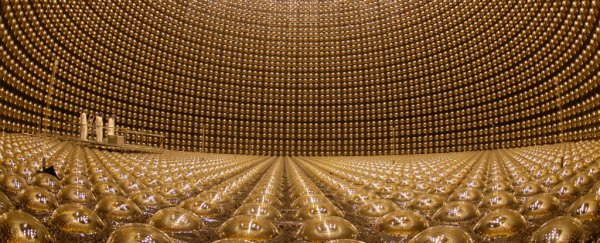This article was written by Ryan Wilkinson and Celine Boehm from Durham University in the UK, and was originally published by The Conversation.
Canada's Arthur B McDonald and Japan's Takaaki Kajita have won this year's Nobel Prize in Physics for their surprising discovery that tiny, subatomic particles called neutrinos have mass. Their experimental results forced scientists to rethink the Standard Model of particle physics that had successfully explained all observations of the subatomic world for decades.
What are neutrinos?
Neutrinos are produced when radioactive isotopes decay and have been shrouded in mystery ever since Wolfgang Pauli first proposed them in 1930. In the Standard Model, they were assumed to have no mass (like particles of light, photons) and be neutral (lacking electric charge). This would also explain why neutrinos usually pass straight through matter without interacting, making them extremely difficult to detect. Enormous instruments are required to observe them in sufficient numbers to study their properties.
Neutrinos were first directly observed by the Cowan-Reines experiment in 1956, using neutrinos from a nuclear reactor and two large tanks of water. If a neutrino interacted with a nucleus in the detector, this would result in a flash of light that could be picked up by photomultiplier tubes that were sandwiched between the tanks. Frederick Reines was awarded the Nobel Prize in 1995 for this work.
 MissMJ - Own work by uploader, PBS NOVA, Fermilab, Office of Science, United States Department of Energy, Particle Data Group
MissMJ - Own work by uploader, PBS NOVA, Fermilab, Office of Science, United States Department of Energy, Particle Data Group
However, when detectors became sensitive enough to observe neutrinos created in nuclear reactions in the Sun, scientists faced a big problem. They had calculated the amount of neutrinos from the Sun that should be hitting Earth, but observed only a third of this number in their experiments. A further Nobel Prize was presented to Ray Davis in 2002 for this discovery. The mystery of these missing neutrinos was coined the "solar neutrino problem" and remained a puzzle for 40 years, until the collaborations led by Kajita and McDonald made their exciting discovery.
Underground discovery
There are three different types, or 'flavour', of neutrino - electron, muon and tau - which have slightly different mass and can interact with other particles in different ways.
In 1998, Kajita, who now works at the University of Tokyo, announced that the Super-Kamiokande experiment in Japan had found that neutrinos 'oscillate' between these flavours, which is possible thanks to the strange rules of quantum mechanics.
Super-Kamiokande detected muon-neutrinos coming straight from the atmosphere above, as well as those hitting the detector from below after having travelled through Earth. Since neutrinos barely interact, there should be equal numbers of neutrinos coming from the two directions. However, the muon-neutrinos that came straight down to Super-Kamiokande were more numerous than those that had passed through the planet. This indicated that muon-neutrinos that travelled longer had more time to oscillate into tau-neutrinos that could evade the detectors.
 Reuters
Reuters
These results were confirmed in 2001 by Arthur B McDonald, based at Queen's University in Canada, and the Sudbury National Observatory collaboration, this time by detecting oscillations of neutrinos from the Sun. By carefully observing the interactions of neutrinos with 'heavy water', they were able to determine the total number of neutrinos, as well as the fraction of electron-neutrinos. They crucially showed that there were no missing neutrinos, once all the flavours had been taken into account.
The discovery of Kajita and McDonald solved the solar neutrino problem as it could explain where the missing neutrinos had gone; they simply changed flavour on their way from the Sun to the detector, meaning that they couldn't be recorded. It also showed that the Standard Model was incomplete, as such oscillations are impossible in the absence of neutrino masses.
From their pioneering work, the neutrino field has boomed across the world, with experiments in every continent. Now that we know neutrinos have mass, we need new theories to explain how they acquire it. If new fundamental particles are responsible for neutrino masses, one of them could account for dark matter, a mysterious substance that makes up the vast majority of the matter in the Universe. Work is ongoing in this area and exciting discoveries may be just around the corner.![]()
Ryan Wilkinson, PhD Candidate in the Institute for Particle Physics Phenomenology, Durham University and Celine Boehm, Senior Lecturer in the Department of Physics, Durham University
This article was originally published on The Conversation. Read the original article.
